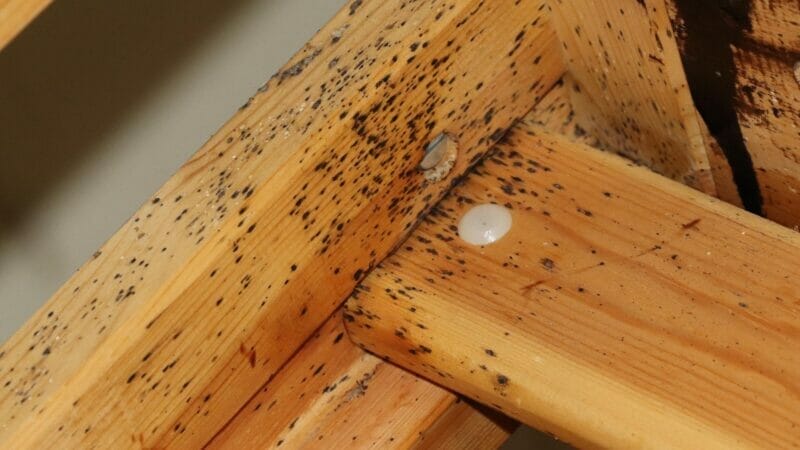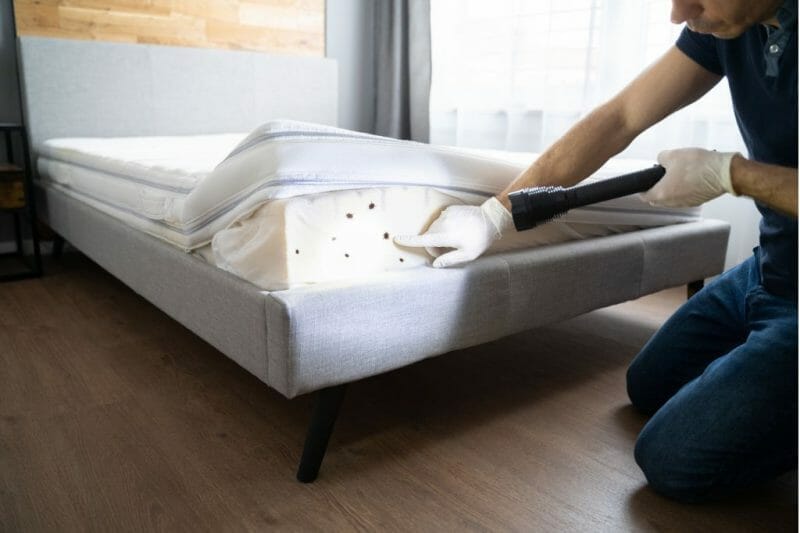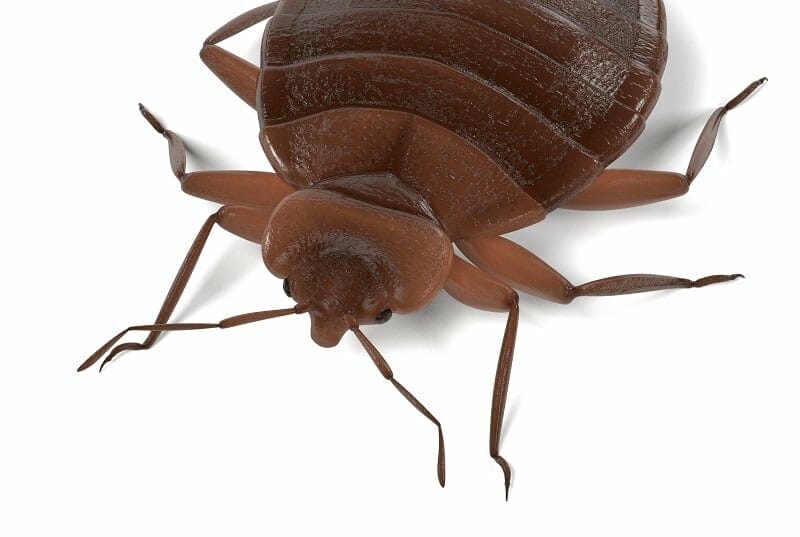Can bed bugs live in cat litter? This is a common concern among pet owners who are dealing with a bed bug infestation in their homes.
However, it’s important to note that bed bugs typically do not infest cat litter. These tiny insects prefer to hide in cracks and crevices near their host, which is usually a human.
Bed bugs are attracted to warmth and the carbon dioxide emitted by humans, making them unlikely to seek shelter in cat litter. Additionally, cat litter contains materials that are not ideal for bed bug survival.
If you suspect a bed bug infestation in your home, it’s essential to focus on areas where humans spend a significant amount of time, such as beds, furniture, and closets.
Consulting a professional exterminator is recommended for effective bed bug elimination and prevention strategies. However, if you want some knowledge on this, we are here to help you.

How to Prevent Bed Bugs from Spreading in Cat Litter
If you are a cat owner and you suspect that your cat litter may be infested with bed bugs, it is important to take immediate action to prevent the spread of these pests. Here are some steps you can take to prevent bed bugs from spreading in cat litter:
1. Identify the Source
The first step in preventing the spread of bed bugs in cat litter is to identify the source of the infestation.
Check your cat’s bedding, sleeping areas, and surrounding furniture for signs of bed bugs. Look for live bugs, eggs, or dark spots on the fabric, which may indicate the presence of these pests.
2. Quarantine the Infested Items
If you discover that your cat litter is infested with bed bugs, it is crucial to quarantine the items immediately.
Remove the cat litter box and any contaminated bedding or toys from your home. Place them in sealed plastic bags to prevent the bugs from spreading to other areas.
3. Wash and Dry on High Heat
Bed bugs cannot survive in high temperatures, so washing the infested items in hot water and drying them on high heat can help eliminate these pests.
Wash your cat’s bedding and toys in hot water and dry them on the highest heat setting recommended for the fabric.
4. Vacuum Thoroughly
After removing the cat litter box, thoroughly vacuum the surrounding area. Pay close attention to corners, cracks, and crevices where bed bugs might hide.
Empty the vacuum bag or canister into a sealed plastic bag and dispose of it immediately to prevent any potential reinfestation.
5. Treat the Area
To prevent bed bugs from spreading in cat litter, it is important to treat the surrounding area. Use a bed bug spray or powder that is specifically designed for treating furniture and pet bedding.
Follow the instructions carefully and apply the treatment to any potential hiding spots for bed bugs.
6. Monitor for Reinfestation
Even after taking the necessary steps to prevent the spread of bed bugs in cat litter, it is essential to monitor for any signs of re-infestation.
Continue to inspect your cat’s bedding and the surrounding area regularly. If you notice any suspicious signs, take prompt action to address the issue.
7. Consult a Professional
If the infestation persists or worsens despite your efforts, it may be necessary to consult a professional pest control company. They have the expertise and tools to effectively eliminate bed bugs and prevent their spread in your home.
In summary, preventing the spread of bed bugs in cat litter requires swift action and thorough cleaning. Identify the source of the infestation, quarantine the infested items, wash and dry on high heat, vacuum thoroughly, treat the area, monitor for reinfestation, and seek professional help if needed. By following these steps, you can effectively prevent bed bugs from spreading in cat litter and protect your home from these unwanted pests.

Signs of Bed Bug Infestation in Cat Litter
Bed bugs are not just a nuisance for humans, but they can also affect our pets, including cats. It’s important to be vigilant and look out for signs of bed bug infestation in your cat’s litter. Here are some common signs to watch out for:
1. Presence of Bed Bugs
The first obvious sign of bed bug infestation in your cat’s litter would be the presence of the bugs themselves.
Bed bugs are small, flat, oval-shaped insects with a reddish-brown color. They are usually around 4-5 mm in length and can be easily seen with the naked eye.
Check the litter box carefully for any signs of these pests.
2. Bite Marks on Your Cat
Bed bugs feed on the blood of warm-blooded animals, including cats. If your cat has been bitten by bed bugs, you may notice red, itchy bite marks on its skin.
These bites are usually small, raised bumps that can be found on areas such as the belly, legs, and neck. Keep an eye out for any signs of bites or excessive scratching in your cat.
3. Presence of Bed Bug Eggs and Shells
Bed bugs reproduce rapidly, and their eggs are usually laid in clusters. Look closely at your cat’s litter for tiny, translucent eggs or empty egg shells.
These eggs are about 1 mm in size and can be found in crevices or corners of the litter box. The presence of eggs or shells is a strong indication of a bed bug infestation.
4. Dark Stains on the Litter
Bed bugs leave behind dark stains of fecal matter on surfaces they infest. Check your cat’s litter for any dark spots or stains.
These stains are usually black or dark brown in color and can be seen on the litter itself or along the sides of the litter box. The presence of these stains is a clear indication of bed bug activity.
5. Unusual Behavior in Your Cat
Bed bug infestations can cause discomfort and irritation in cats. If your cat is constantly scratching, grooming excessively, or seems restless, it could be a sign of bed bug bites.
Monitor your cat’s behavior closely and consult with a veterinarian if you notice any unusual signs.
6. Shedded Bed Bug Skins
As bed bugs grow and develop, they shed their exoskeletons or skins. These discarded skins can be found in areas where bed bugs hide, including your cat’s litter box.
Look for translucent, shell-like skins that resemble the shape of a bed bug. The presence of shedded skins confirms an active bed bug infestation.
In summary, it’s important to regularly inspect your cat’s litter box for signs of bed bug infestation. If you suspect a bed bug problem, take immediate action to eliminate the pests and consult with a professional pest control service, as bed bugs can be difficult to eradicate on your own. By being proactive and vigilant, you can keep your cat safe and prevent any further infestations.

Proper Cleaning and Disposal Techniques for Cat Litter to Avoid Bed Bugs
When it comes to taking care of our pets, ensuring their hygiene is of utmost importance. This includes properly cleaning and disposing of cat litter to prevent the infestation of bed bugs, which can be a major nuisance for both cats and humans. In this section, we will discuss the steps you can take to effectively clean and dispose of cat litter.
1. Choose the Right Type of Cat Litter
The first step in preventing bed bugs is to choose the right type of cat litter. Opt for a litter that is specifically designed to minimize dust, as dust particles can attract bed bugs.
Additionally, consider using a litter that has been treated with natural bed bug repellents, such as diatomaceous earth or essential oils.
2. Use a High-Quality Litter Box and Liners
Invest in a high-quality litter box that is easy to clean and has a secure lid. Bed bugs can easily hide in cracks and crevices, so make sure the litter box is free of any potential hiding spots. Consider using liners for the litter box, as this will make cleaning and disposal much easier.
3. Regularly Scoop and Dispose of Cat Waste
One of the most important steps in maintaining a clean litter box is to regularly scoop out cat waste.
Bed bugs are attracted to feces and urine, so removing it promptly will help deter them. Place the waste in a sealed bag before disposing of it in an outdoor trash bin.
4. Clean the Litter Box Frequently
In addition to scooping out waste, it is essential to thoroughly clean the litter box on a regular basis.
Use mild detergent and warm water to scrub the box, ensuring that all residue is removed. Rinse it thoroughly and allow it to dry completely before refilling it with fresh litter.
5. Disinfect the Litter Box
To further prevent the infestation of bed bugs, it is advisable to periodically disinfect the litter box.
You can use a mixture of water and vinegar or a pet-safe disinfectant solution. Make sure to follow the manufacturer’s instructions when using any cleaning products.
6. Dispose of Used Cat Litter Properly
Proper disposal of used cat litter is crucial in preventing the spread of bed bugs. Never flush cat litter down the toilet, as it can clog pipes and contaminate water sources.
Instead, double-bag the used litter and place it in a sealed trash bag before disposing of it in an outdoor garbage bin.
7. Maintain a Clean and Hygienic Environment
In addition to following proper cleaning and disposal techniques for cat litter, it is important to maintain a clean and hygienic environment overall.
Vacuum regularly, especially around the litter box area, to remove any potential bed bug eggs or larvae. Wash your hands thoroughly after handling cat litter to reduce the risk of spreading any contaminants.
Nontoxic and Natural Remedies to Eliminate Bed Bugs in Cat Litter
If you’re looking for a natural approach to get rid of bed bugs, you may be surprised to learn that cat litter can be a useful tool in your battle against these pesky pests.
1. Diatomaceous Earth
Diatomaceous earth is a natural substance that is lethal to bed bugs but safe for humans and pets. It is made from the fossilized remains of tiny aquatic organisms called diatoms. The microscopic particles of diatomaceous earth have sharp edges that cut through the exoskeleton of bed bugs, causing them to dehydrate and die.
To use diatomaceous earth in cat litter for bed bug control, sprinkle a thin layer of the powder around the areas where you suspect bed bugs are hiding. This could include cracks in the walls, baseboards, and under furniture. Leave the cat litter with diatomaceous earth in place for a few days, then vacuum it up along with any dead bed bugs.
2. Cedar Chips
Cedar chips are another natural remedy that can help repel and eliminate bed bugs. Cedar has natural properties that are toxic to these pests, making it an effective deterrent. You can find cedar chips at your local pet store or garden center.
To use cedar chips in cat litter for bed bug control, mix the chips with the litter and place it in areas where you suspect bed bug activity. The scent of cedar will not only repel bed bugs but also help to mask their pheromones, making it harder for them to find their way back to their hiding spots.
3. Lavender Oil
Lavender oil is well-known for its calming scent, but it can also be used as a natural remedy for bed bug control. Bed bugs are repelled by the strong odor of lavender oil, making it an effective deterrent.
To use lavender oil in cat litter for bed bug control, mix a few drops of the oil with the litter and place it in areas where bed bugs are present. The lavender scent will help to repel the bugs and discourage them from returning.
4. Baking Soda
Baking soda is a versatile household ingredient that can also be used to eliminate bed bugs. It works by dehydrating the pests and disrupting their exoskeleton, causing them to die.
To use baking soda in cat litter for bed bug control, sprinkle a thin layer of the powder around the infested areas. Leave it for a few days, then vacuum it up along with any dead bed bugs.
5. Silica Gel
Silica gel is a desiccant commonly used to control moisture. It can also be effective in eliminating bed bugs. The gel absorbs the moisture from the bugs, causing them to dehydrate and die.
To use silica gel in cat litter for bed bug control, mix it with the litter and place it in areas where bed bugs are hiding. Leave it for a few days, then vacuum it up along with any dead bed bugs.
Conclusion
In conclusion, while bed bugs are known to be excellent hitchhikers and can hide in various surfaces, including clothing, furniture, and even electronics, there is no evidence to suggest that they can live in cat litter.
Bed bugs primarily survive by feeding on human blood and prefer to hide in close proximity to their human hosts. Cat litter does not provide the necessary environment or food source for bed bugs to thrive.
However, it is essential to maintain good hygiene and cleanliness in your home, including properly disposing of used cat litter, as it can attract other pests and insects. If you suspect a bed bug infestation in your home, it is recommended to consult a professional pest control company for effective treatment and prevention.
Remember, regular inspection, proper sanitation, and early detection are key to preventing and managing any pest-related issues in your living environment, ensuring a clean and comfortable space for both you and your furry companions.


